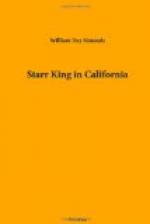Padres planted a chain of missions extending from
San Diego to the Bay of San Francisco. At these
missions, consisting often, at the beginning, of nothing
more than a rude cross and altar, with some miserable
make-shift of tent or huts as protection from the
heat of summer and the cold of winter, the faithful
priests labored to convert the surrounding Indians.
They tried to make of them not alone good Catholics,
but good farmers, and vineyardists, and according
to the need of the time, capable carpenters and builders.
As the result of their labors a long period of simple
prosperity was enjoyed at the missions. Buildings
were erected that still delight the traveler.
They were for the most part of Moorish architecture,
built of adobe, painted white, with red-tile roofs,
long corridors and ever the secluded plaza where the
friar might tell his beads in peace. Around the
missions, some twenty in number, lying a day’s
journey apart between the southern and the central
bay, Indian workers cultivated immense fields of grain,
choice vineyards, olive orchards and orange groves;
great herds of horses, cattle, and sheep were cared
for, and the women became adept at weaving and spinning.
Nor were the Spanish Governors idle. They encouraged
the immigration of settlers both from the mother country
and Mexico by a most liberal policy, assisting the
newcomer to build a home, acquire stock, and establish
himself in a country where there was an abundance
of game, and where the earth yielded her bounty with
the minimum of labor. Thus in the half century
between 1770 and 1820, these Pius Padres laid the
foundations of California, as they believed securely,
after Catholic and Spanish tradition.
Not securely so it proved, for in 1822 Mexico won
her independence from Spain, both political and religious.
The California Padres being Spaniards naturally suffered
persecution at the hands of successive Mexican Governors,
who were envious of the lands, orchards and herds of
domestic animals belonging to the various missions.
Ruthlessly the Friars were plundered of their well
tilled fields, their fine vineyards, their flocks
and herds, and their Indian converts were enticed or
driven into the service of the new Masters of the
country. Some of these officials were of Spanish
blood and some of Mexican but now they proudly called
themselves, Californians. And proudly they lived,
these Spanish and Mexican Dons. Owning immense
tracts of land, riding upon fleet horses, relieved
of all necessity of honest work, they soon became in
their manner of living, veritable hidalgoes.
Vain, ridiculously boastful, pleasure chasers, they
loved above all else the frolic, the dance, and a
good horse. All the way from San Diego to Shasta
were located the immense ranchoes, more than six hundred
in number, ever since celebrated in song and story.
This was the period so often called by poetic writers
the Romantic Age of California. Although much
of the glamor of the dear old days of plenty and pleasure




